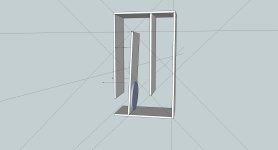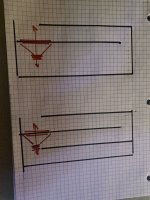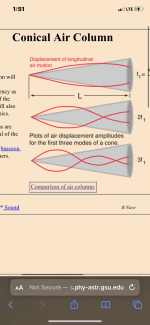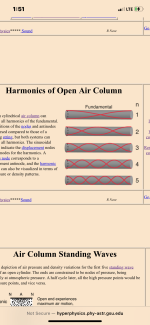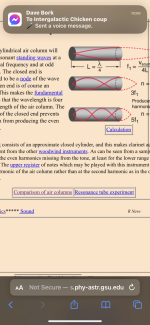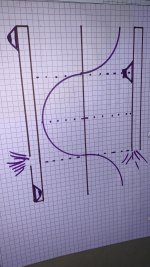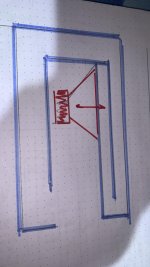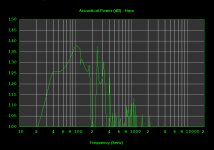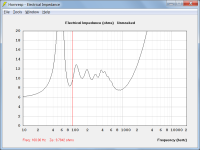This alignment 'begs' for a high Qt driver which in turn specs a longer CTC distance from the terminus/driver centerline, so either find the right Qt and/or the right frame driver.
Hadn't really given it any thought in that 'we' never came up with this type of alignment per se; 'we' just experimented with corner loaded full room height pipes (0.354 or 0.25 pi space?, either way 'mucho' wide BW gain!) with drivers at each end and trying different 3rd driver options (4th ones 'muddied' it up) along its length, eventually creating a rather surprisingly simple/'dirt' cheap ('freebie' drivers/horns from all the mono radios & HIFI consoles junked for stereo) 'FR' 'infinite' line array. Note that this was in an era of rather/very lossy rooms down here in the Deep South where in only the relatively wealthy had well sealed rooms, full house A/C and being PP tube driven, variable DF bass/treble tone controls.
Without doing any comparison sims, seems like the extra section would yield a wider HF BW, overall increased damping.
Without doing any comparison sims, seems like the extra section would yield a wider HF BW, overall increased damping.
ID = 54.10
Comment = NEW RECORD - NEW RECORD - NEW RECORD - NEW RECORD - NEW RECORD - NEW RECORD
|RADIATION, SOURCE AND MOUTH PARAMETER VALUES:
Ang = 2.0 x Pi
Eg = 66.00
Rg = 0.00
Fta = 0.00
|HORN PARAMETER VALUES:
S1 = 1800.00
S2 = 1800.00
Par = 0.01
F12 = 0.00
S2S = 1800.00
S3 = 1800.00
Par = 70.00
F23 = 0.00
S3S = 450.00
S4 = 450.00
Par = 70.00
F34 = 0.00
S4S = 0.00
S5 = 0.00
L45 = 0.00
F45 = 0.00
|TRADITIONAL DRIVER PARAMETER VALUES:
Sd = 1241.00
Bl = 34.89
Cms = 7.99E-05
Rms = 13.98
Mmd = 327.10
Le = 2.80
Re = 3.30
OD = 1
|ADVANCED DRIVER PARAMETER VALUES FOR SEMI-INDUCTANCE MODEL:
Re' = 0.00
Leb = 0.00
Le = 0.00
Ke = 0.00
Rss = 0.00
|ADVANCED DRIVER PARAMETER VALUES FOR FREQUENCY-DEPENDENT DAMPING MODEL:
Rms = 0.00
Ams = 0.00
|PASSIVE RADIATOR PARAMETER VALUE:
Added Mass = 0.00
|CHAMBER PARAMETER VALUES:
Vrc = 0.00
Lrc = 0.00
Fr = 0.00
Tal = 0.00
Vtc = 0.00
Atc = 0.00
Acoustic Path Length = 0.0
|MAXIMUM SPL PARAMETER VALUES:
Pamp = 100
Vamp = 25
Iamp = 4
Pmax = 1700
Xmax = 16.5
Maximum SPL Setting = 3
|ABSORBENT FILLING MATERIAL PARAMETER VALUES:
Fr1 = 0.00
Fr2 = 0.00
Fr3 = 0.00
Fr4 = 0.00
Tal1 = 100
Tal2 = 100
Tal3 = 100
Tal4 = 100
|ACTIVE BAND PASS FILTER PARAMETER VALUES:
High Pass Frequency = 0
High Pass Slope = 1
Low Pass Frequency = 0
Low Pass Slope = 1
Butterworth High Pass Order = 1
Butterworth Low Pass Order = 1
Linkwitz-Riley High Pass Order = 2
Linkwitz-Riley Low Pass Order = 2
Bessel High Pass Order = 1
Bessel Low Pass Order = 1
2nd Order High Pass Q = 0.5
2nd Order Low Pass Q = 0.5
4th Order High Pass Q = 0.5
4th Order Low Pass Q = 0.5
Active Filter Alignment = 1
Active Filter On / Off Switch = 1
|PASSIVE FILTER PARAMETER VALUES:
Series / Parallel 1 = S
Series / Parallel 2 = S
Series / Parallel 3 = S
Series / Parallel 4 = S
|EQUALISER FILTER PARAMETER VALUES:
Band 1 Frequency = 0
Band 1 Q Factor = 0.01
Band 1 Gain = 0.0
Band 1 Type = -1
Band 2 Frequency = 0
Band 2 Q Factor = 0.01
Band 2 Gain = 0.0
Band 2 Type = -1
Band 3 Frequency = 0
Band 3 Q Factor = 0.01
Band 3 Gain = 0.0
Band 3 Type = -1
Band 4 Frequency = 0
Band 4 Q Factor = 0.01
Band 4 Gain = 0.0
Band 4 Type = -1
Band 5 Frequency = 0
Band 5 Q Factor = 0.01
Band 5 Gain = 0.0
Band 5 Type = -1
Band 6 Frequency = 0
Band 6 Q Factor = 0.01
Band 6 Gain = 0.0
Band 6 Type = -1
|STATUS FLAGS:
Auto Path Flag = 0
Lossy Inductance Model Flag = 1
Semi-Inductance Model Flag = 0
Damping Model Flag = 0
Closed Mouth Flag = 0
Continuous Flag = 0
|OTHER SETTINGS:
Filter Type Index = 0
Filter Input Index = 0
Filter Output Index = 0
Filter Type = 1
MEH Configuration = 0
ME Amplifier Polarity Value = 1
(I dumbed it down so I could compare /contrast)
1800cm2 @ 70 cm with 450 cm2 @ 70 cm
verses
900cm2/900cm2/450cm2 @70cm
1800cm2 @ 70 cm with 450 cm2 @ 70 cm
verses
900cm2/900cm2/450cm2 @70cm
🤣😂, I see your point tho'. The BR looks better than the TL.
this is what I noticed as well and it put a dent in my infatuation with 1/4 wave 🥲😝 (cognitive dissonance, lol)
Isn’t it still ‘1/4 wave’ except the affective ‘shape’ of the ‘resonator’ has a stepped reduction in it?
if I put it in a generic sim of VRc/Lrc and ap/Lpt and I retain the exact same ‘Volume’, but drastically reduce ‘LRC’ ….
(don’t change anything else ) …. See what I mean?
if I put it in a generic sim of VRc/Lrc and ap/Lpt and I retain the exact same ‘Volume’, but drastically reduce ‘LRC’ ….
(don’t change anything else ) …. See what I mean?
I thought 1/4 wave equals some type of bandpass enclosure where the speaker is mounted inside the box?
Post 403 = 1/4 wave.
Post 405 = BR.
I know you guys prefer TL's (fancy BR's) for their easy builds and sometimes better modeled performance over a TH. However, NO proper BR can beat the sound of a proper BP enclosure.
The ease of clean bass that comes out of a bandpass enclosure is unreal due to lower distortion (less cone movement).
Go over to AVSFORUM.COM and checkout the posts from guys who had both Marty and Devastator enclosures with the same driver. No competition. And, Devastators are not properly designed enclosures. They have inherited large bumps in the midbass region, yet they say it crushes Marty enclosures.
I have begun to understand why people talk about 1 note bass from BP enclosures. When they hear a BP enclosure, they are probably listening to Hip Hop. 808 bass is LITERALLY a decay function on the Roland TR-808 drum machine. Decay = ringing to audiophiles. Most audiophiles don't like Hip Hop. What they don't know is a lot of Hip Hop was made from records that audiophiles listen to. But, ignorance is bliss and I'm just a basshead.
Go to whosampled.com, search your favorite audiophile song, album, or artist and I bet that music was sampled in a Hip Hop track. The website let's you hear both tracks and includes skipping to the exact point of when the sample is used.
Post 403 = 1/4 wave.
Post 405 = BR.
I know you guys prefer TL's (fancy BR's) for their easy builds and sometimes better modeled performance over a TH. However, NO proper BR can beat the sound of a proper BP enclosure.
The ease of clean bass that comes out of a bandpass enclosure is unreal due to lower distortion (less cone movement).
Go over to AVSFORUM.COM and checkout the posts from guys who had both Marty and Devastator enclosures with the same driver. No competition. And, Devastators are not properly designed enclosures. They have inherited large bumps in the midbass region, yet they say it crushes Marty enclosures.
I have begun to understand why people talk about 1 note bass from BP enclosures. When they hear a BP enclosure, they are probably listening to Hip Hop. 808 bass is LITERALLY a decay function on the Roland TR-808 drum machine. Decay = ringing to audiophiles. Most audiophiles don't like Hip Hop. What they don't know is a lot of Hip Hop was made from records that audiophiles listen to. But, ignorance is bliss and I'm just a basshead.
Go to whosampled.com, search your favorite audiophile song, album, or artist and I bet that music was sampled in a Hip Hop track. The website let's you hear both tracks and includes skipping to the exact point of when the sample is used.
BP....90 to 30hz flat ... 300 to 400 liters... 12 or 15 driver... Single or dual..
18mm plywood.... 12mm for bracing
140db with 4 cabs
Possible??
😜🍻🍺🥂🍾🍷🥃
18mm plywood.... 12mm for bracing
140db with 4 cabs
Possible??
😜🍻🍺🥂🍾🍷🥃
1/4 wave? Land on a resonance in phase at velocity max or piggy back it in parallel. But in the case of ‘paraflex’ be careful 🤮🙈🤔. If misaligned that sh!t sounds weird (at best), especially if it starts ringing . Maybe the ‘devastator’ isn’t so finicky ?
Attachments
Last edited:
I dont understand how a ‘TH’ is suppose to sound ‘better’ when it’s just gathering all those 1/4 wave resonances together and abbreviating the useful part of bandwidth or polluting it up top with midbass funk?
or maybe even worse, adding a random resonator in parallel to further booger that up?
or maybe even worse, adding a random resonator in parallel to further booger that up?
Bandpass systems (Ok, bandpass systems that use Helmholtz resonators to limit the passband because technically every subwoofer build is a bandpass design), like other systems, have their advantages and their disadvantages. Their main advantage IMO is the acoustic filtering provided by the vents. The disadvantage is the dynamic compression that can result because of the use of said vents for ALL of their output. And once you start using vents large enough to minimize that compression, you're into 1/4 wave territory, and out of band resonances become more pronounced, limiting the distortion-reducing effect. A TH is basically an example of a 6th order series-tuned BP taken to its logical limit, the result being little compression caused by the design, but pretty significant out of band resonance effects.
My first ‘parallel’ qw pipe was an epic fail (the ‘one note wonder’ wast even a ‘subwoofer’ freq 🙈and the car audio driver ciuldnt wait to go nuts at that sloppy area of resonance .I thought 1/4 wave equals some type of bandpass enclosure where the speaker is mounted inside the box?
Post 403 = 1/4 wave.
Post 405 = BR.
I know you guys prefer TL's (fancy BR's) for their easy builds and sometimes better modeled performance over a TH. However, NO proper BR can beat the sound of a proper BP enclosure.
The ease of clean bass that comes out of a bandpass enclosure is unreal due to lower distortion (less cone movement).
Go over to AVSFORUM.COM and checkout the posts from guys who had both Marty and Devastator enclosures with the same driver. No competition. And, Devastators are not properly designed enclosures. They have inherited large bumps in the midbass region, yet they say it crushes Marty enclosures.
I have begun to understand why people talk about 1 note bass from BP enclosures. When they hear a BP enclosure, they are probably listening to Hip Hop. 808 bass is LITERALLY a decay function on the Roland TR-808 drum machine. Decay = ringing to audiophiles. Most audiophiles don't like Hip Hop. What they don't know is a lot of Hip Hop was made from records that audiophiles listen to. But, ignorance is bliss and I'm just a basshead.
Go to whosampled.com, search your favorite audiophile song, album, or artist and I bet that music was sampled in a Hip Hop track. The website let's you hear both tracks and includes skipping to the exact point of when the sample is used.
later on i would build these as 3:1 resonators (bose) and everything became infinitely better
Attachments
That BP6S basically has a higher tuned Devastator BP6P response.
What were your high and low filter settings?
I thought those BP6S' with BP6P type exits were problematic?
What were your high and low filter settings?
I thought those BP6S' with BP6P type exits were problematic?
I wish I could decipher the impedance plot in that areaMy first ‘parallel’ qw pipe was an epic fail (the ‘one note wonder’ wast even a ‘subwoofer’ freq 🙈and the car audio driver ciuldnt wait to go nuts at that sloppy area of resonance .
later on i would build these as 3:1 resonators (bose) and everything became infinitely better
Attachments
I wish I could decipher the impedance plot in that area
Not sure what you mean by the above, or if the following helps, but the range on the Hornresp impedance chart can be changed if required. The data can also exported for even closer examination if necessary.
Attachments
- Home
- Loudspeakers
- Subwoofers
- Lab12 - Tapped Horn
